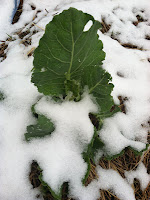I think the term global warming has done a huge amount of damage to the envormentalist movement against climate change. The term climate change much better captures what we are experiencing. We are not just seeing hotter summers and more mild winters, but droughts, floods, cold snaps out of season, and heat waves out of place. Wednesday afternoon the temperature reached into the upper 80s, Thursday night it dropped to below freezing! It even snowed!
I enjoy a nice snow in January. But once the irises have bloomed, peach blossums have dropped, and lettuce is popping up, I do not wish to see any snow! The biggest problem with climate change, of any kind, is its affects on gardens and food production. We may not like seeing snow in May or dangerous heat waves in August, but our comfort is not an issue. However, if lettuce is frozen and dies in May and beans can not survive the heat and drought, what will we all eat!
In my garden, I avoid planting anything that is not freeze tolerant until after April 15th. In the past that seems to be a safe date to start assuming the freezing tempertures are behind us. By May we are often hoping the plants don't go to seed too early in the heat. Frost has never been an issue this late in the season in my lifetime. I had plenty of plants in my garden that would not tolerate the snow. Luckily, I watched the weather and knew the cold front was on its way. In fact, the weather application on my husbands phone woke me up several times throughout the night beeping and alerting me to the freeze watch that was in effect. Most of the plants I have above ground are tolerant to a light freeze, but I needed to covered my tomatoes, peppers, and delicate leafy greens.

This year I found a simple, cheap, and effective way to cover my vegetables. I built temporary, miniature hoop houses. I used a roll of thick old wire that had been sitting under leaves in my father's back yard. I cut my wire in big half circles (or more like 3/4 circles), their shape was already perfect for my minutes hoop house. I took the pieces of wire and poked the ends into the ground on either side of the garden bed. I could have bought clear plastic to cover the hoop houses, but instead I tried just using old bedsheets, since I had them lying around already. All season I left the hoops bridging the beds and just threw the sheets over them when there was a chance of a freeze. It was much easier than I would have thought and cost me nothing. Most importantly, it saved my little plants!
Do you have a garden?
How did it do in this unseasonably cold front?
Share your ideas for protecting your garden against spring frosts!






